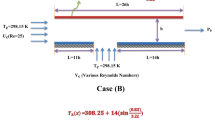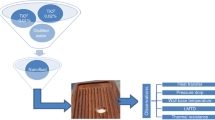Abstract
Due to the acceptable performance of microchannel heat sinks in electronic components, their performance enhancement in repelling the high heat fluxes has received much attention. In this research, the effects of applying the hybrid nanofluid flows in a double-layer microchannel heat sink with superhydrophobic walls are investigated numerically. The finite volume method is used to perform numerical simulations of the 3D solid–liquid conjugate model. The conventional straight microchannel containing pure water is considered as the base case and the aim is to increase the thermohydraulic performance of these channels by using hybrid nanofluid, converging channels, and superhydrophobic surfaces. The results indicate that at low Re numbers, the thermal resistance of the hybrid nanofluid in the superhydrophobic microchannel (in all values of tapered factor) is lower than that of the conventional microchannel with pure water. However, at high Re numbers, the situation is reversed. This is due to the higher temperature jumps at the wall contact surfaces for high Re numbers. Also, the excessive pumping power caused by the nanoparticles for volume fractions less than 3% can be compensated with superhydrophobic surfaces.










Similar content being viewed by others
Abbreviations
- A :
-
Channel inlet area, m2
- \(c_{{\text{p}}}\) :
-
Specific heat capacity, \({\text{J Kg}}^{ - 1} {\text{K}}^{ - 1}\)
- \(D_{{\text{h}}}\) :
-
Hydraulic diameter, m
- \(d\) :
-
Diameter of nanoparticles, m
- \(h_{{\text{m}}}\) :
-
Mean coefficient of convection heat transfer, \({\text{Wm}}^{ - 2} {\text{K}}^{ - 1}\)
- \(k\) :
-
Thermal conductivity, \({\text{Wm}}^{ - 1} {\text{K}}^{ - 1}\)
- \(k_{{\text{b}}}\) :
-
Boltzmann constant
- \(l_{{\text{s}}}\) :
-
Slip length, μm
- \(L_{{\text{x}}}\) :
-
Length of heat sink, μm
- \(L_{{\text{y}}}\) :
-
Width of heat sink, μm
- \(L_{{\text{z}}}\) :
-
Height of heat sink, μm
- N :
-
Number of channels
- \({\text{Nu}}_{{\text{m}}}\) :
-
Mean Nu number
- \(p\) :
-
Pressure, Pa
- \(q\prime \prime_{{\text{s}}}\) :
-
Heat flux, \({\text{Wm}}^{ - 2}\)
- \({\text{Re}}\) :
-
Re number
- \({\text{Re}}_{{\text{p}}}\) :
-
Reynolds number of nanoparticles
- \({\text{R}}_{{{\text{th}}}}\) :
-
Thermal resistance, KW−1
- T :
-
Temperature, K
- \(\overline{T}_{{\text{s}}}\) :
-
Mean solid temperature, K
- \(t_{{\text{s}}}\) :
-
Thickness of plates, μm
- TF :
-
Tapered factor
- W :
-
Total microchannel width, μm
- \(W_{{\text{c}}}\) :
-
Width of channel, μm
- \(W_{{\text{s}}}\) :
-
Width of vertical walls, μm
- \(\Delta p\) :
-
Pressure loss, Pa
- \({\uprho }\) :
-
Density, Kg \({\text{m}}^{ - 3}\)
- \({\upmu }\) :
-
Absolute viscosity, Pa.s
- \(\varphi\) :
-
Nanoparticles volume concentrations
- \({\Omega }\) :
-
Power of pumping, W
- f :
-
Fluid
- fr :
-
Freezing point
- in:
-
Inlet
- m :
-
Mean or average
- max:
-
Maximum
- out:
-
Outlet
- s :
-
Solid part
- w :
-
Water
References
Tuckerman DB, Pease RFW. High-performance heat sinking for VLSI. IEEE Electron Device Lett. 1981;2:126–9. https://doi.org/10.1109/EDL.1981.25367.
Vafai K, Zhu L. Analysis of two-layered micro-channel heat sink concept in electronic cooling. Int J Heat Mass Transf. 1999;42:2287–97. https://doi.org/10.1016/S0017-9310(98)00017-9.
Wei X, Joshi Y, Patterson MK. Experimental and numerical study of a stacked microchannel heat sink for liquid cooling of microelectronic devices. J Heat transf. 2007;129:1432–44. https://doi.org/10.1115/1.2754781.
Wu JM, Zhao JY, Tseng KJ. Parametric study on the performance of double-layered microchannels heat sink. Energ Conver Manag. 2014;80:550–60. https://doi.org/10.1016/j.enconman.2014.01.014.
Riaz A, Ellahi R, Sait SM. Role of hybrid nanoparticles in thermal performance of peristaltic flow of Eyring-Powell fluid model. J Therm Anal Calorim. 2021;143:1021–35. https://doi.org/10.1007/s10973-020-09872-9.
Pourmehran O, Rahimi-Gorji M, Hatami M, Sahebi SAR, Domairry G. Numerical optimization of microchannel heat sink (MCHS) performance cooled by KKL based nanofluids in saturated porous medium. J Taiwan Inst Chem Eng. 2015;55:49–68. https://doi.org/10.1016/j.jtice.2015.04.016.
Saffarian MR, Moravej M, Doranehgard MH. Heat transfer enhancement in a flat plate solar collector with different flow path shapes using nanofluid. Renew Energ. 2020;146:2316–29. https://doi.org/10.1016/j.renene.2019.08.081.
Sohani A, Delfani F, Hosseini M, Sayyaadi H, Karimi N, Li LKB, Doranehgard MH. Price inflation effects on a solar-geothermal system for combined production of hydrogen, power, freshwater and heat. Int J Hydro Energ. 2022. https://doi.org/10.1016/j.ijhydene.2022.04.130.
Bhatti MM, Alamri SZ, Ellahi R, Abdelsalam SI. Intra-uterine particle–fluid motion through a compliant asymmetric tapered channel with heat transfer. J Therm Anal Calorim. 2021;144:2259–67. https://doi.org/10.1007/s10973-020-10233-9.
Ho CJ, Guo YW, Yang TF, Rashidi S, Yan WM. Numerical study on forced convection of water-based suspensions of nanoencapsulated PCM particles/Al2O3 nanoparticles in a mini-channel heat sink. Int J Heat Mass Transf. 2020;157: 119965. https://doi.org/10.1016/j.ijheatmasstransfer.2020.119965.
Ho CJ, Hsu ST, Yang TF, Chen BL, Rashidi S, Yan WM. Cooling performance of mini-channel heat sink with water-based nano-PCM emulsion-An experimental study. Int J Therm Sci. 2021;164: 106903. https://doi.org/10.1016/j.ijthermalsci.2021.106903.
Alizadeh R, Karimi N, Arjmandzadeh R, Mehdizadeh A. Mixed convection and thermodynamic irreversibilities in MHD nanofluid stagnation-point flows over a cylinder embedded in porous media. J Therm Anal Calorim. 2019;135:489–506. https://doi.org/10.1007/s10973-018-7071-8.
Balaji T, Selvam C, MohanLal D, Harish S. Enhanced heat transport behavior of micro channel heat sink with graphene based nanofluids. Int Commun Heat Mass Transf. 2020;117: 104716. https://doi.org/10.1016/j.icheatmasstransfer.2020.104716.
He W, Mashayekhi R, Toghraie D, AliAkbari O, Li Z, Tlili I. Hydrothermal performance of nanofluid flow in a sinusoidal double layer microchannel in order to geometric optimization. Int Commun Heat Mass Transf. 2020;117: 104700. https://doi.org/10.1016/j.icheatmasstransfer.2020.104700.
Yang L, Du K. Numerical simulation of nanofluid flow and heat transfer in a microchannel: The effect of changing the injection layout arrangement. Int J Mech Sci. 2020;172: 105415. https://doi.org/10.1016/j.ijmecsci.2019.105415.
Moghadasi H, Aminian E, Saffari H, Mahjoorghani M, Emamifar A. Numerical analysis on laminar forced convection improvement of hybrid nanofluid within a U-bend pipe in porous media. Int J Mech Sci. 2020;179: 105659.
Sohani A, Sayyaadi H, Cornaro C, Shahverdian MH, Pierro M, Moser D, Karimi N, Doranehgard MH, Li LKB. Using machine learning in photovoltaics to create smarter and cleaner energy generation systems: a comprehensive review. J Clean Prod. 2022;364: 132701. https://doi.org/10.1016/j.jclepro.2022.132701.
Sohani A, Delfani F, Hosseini M, Sayyaadi H, Karimi N, Li LKB, Doranehgard MH. Dynamic multi-objective optimization applied to a solar-geothermal multi-generation system for hydrogen production, desalination, and energy storage. Int J Hydro Energ. 2022. https://doi.org/10.1016/j.ijhydene.2022.03.253.
Zhang L, Bhatti MM, Michaelides EE, Marin M, Ellahi R. Hybrid nanofluid flow towards an elastic surface with tantalum and nickel nanoparticles, under the influence of an induced magnetic field. Eur Phys J Spec Top. 2022;231:521–33. https://doi.org/10.1140/epjs/s11734-021-00409-1.
Sarvar-Ardeh S, Rafee R, Rashidi S. Hybrid nanofluids with temperature-dependent properties for use in double-layered microchannel heat sink; hydrothermal investigation. J Taiwan Inst Chem Eng. 2021;124:53–62. https://doi.org/10.1016/j.jtice.2021.05.007.
Wang J, Xu YP, Qahiti R, Jafaryar M, Alazwari MA, Abu-Hamdeh NH, Issakhov A, Selim MM. Simulation of hybrid nanofluid flow within a microchannel heat sink considering porous media analyzing CPU stability. J Petrol Sci Eng. 2022;208: 109734. https://doi.org/10.1016/j.petrol.2021.109734.
Dehghan M, Daneshipour M, Valipour MS, Rafee R, Saedodin S. Enhancing heat transfer in microchannel heat sinks using converging flow passages. Energ Conver Manage. 2015;92:244–50. https://doi.org/10.1016/j.enconman.2014.12.063.
Osanloo B, Mohammadi-Ahmar A, Solati A, Baghani M. Performance enhancement of the double-layered micro-channel heat sink by use of tapered channels. Appl Therm Eng. 2016;102:1345–54.
Wong KC, Ang ML. Thermal hydraulic performance of a double-layer microchannel heat sink with channel contraction. Int Commun Heat Mass Transfer. 2017;81:269–75. https://doi.org/10.1016/j.icheatmasstransfer.2016.09.013.
Kumar A, Nath S, Bhanja D. Effect of nanofluid on thermo hydraulic performance of double layer tapered microchannel heat sink used for electronic chip cooling. Num Heat Trans, Part A: Appl. 2018;73(7):429–45. https://doi.org/10.1080/10407782.2018.1448611.
Dadsetani R, Sheikhzade GA, Goodarzi M, Zeeshan A, Ellahi R, Safaei MR. Thermal and mechanical design of tangential hybrid microchannel and high-conductivity inserts for cooling of disk-shaped electronic components. J Therm Anal Calorim. 2021;143:2125–33. https://doi.org/10.1007/s10973-020-10232-w.
Ou J, Rothstein JP. Direct velocity measurements of the flow past drag-reducing ultrahydrophobic surfaces. Phy of Fluids. 2005;17: 103606. https://doi.org/10.1063/1.2109867.
Hsieh SS, Lin CY. Convective heat transfer in liquid microchannels with hydrophobic and hydrophilic surfaces. Int J Heat Mass Transf. 2009;52:260–70. https://doi.org/10.1016/j.ijheatmasstransfer.2008.05.021.
Ermagan H, Rafee R. Geometric optimization of an enhanced microchannel heat sink with superhydrophobic walls. Appl Therm Eng. 2018;130:384–94. https://doi.org/10.1016/j.applthermaleng.2017.11.039.
Ermagan H, Rafee R. Effect of pumping power on the thermal design of converging microchannels with superhydrophobic walls. Int J Therm Sci. 2018;132:104–16. https://doi.org/10.1016/j.ijthermalsci.2018.05.051.
Ermagan H, Rafee R. Numerical investigation into the thermo-fluid performance of wavy microchannels with superhydrophobic walls. Int J Therm Sci. 2018;132:578–88. https://doi.org/10.1016/j.ijthermalsci.2018.06.035.
Ghadirzadeh S, Kalteh M. Lattice Boltzmann simulation of temperature jump effect on the nanofluid heat transfer in an annulus microchannel. Int J Mech Sci. 2017;133:524–34. https://doi.org/10.1016/j.ijmecsci.2017.09.013.
Heidarian A, Rafee R, Valipour MS. Effects of hydrophobicity on the thermohydraulic performance of the microchannel with nanofluids. Int Commun Heat Mass Transf. 2020;117: 104758. https://doi.org/10.1016/j.icheatmasstransfer.2020.104758.
Heidarian A, Rafee R, Valipour MS. Hydrodynamic analysis of the nanofluids flow in a microchannel with hydrophobic and superhydrophobic surfaces. J Taiwan Inst Chem Eng. 2021;124:266–75. https://doi.org/10.1016/j.jtice.2021.04.002.
Sarvar-Ardeh S, Rafee R, Rashidi S. A comparative study on the effects of channel divergence and convergence on the performance of two-layer microchannels. Exp Tech. 2022. https://doi.org/10.1007/s40799-022-00546-9.
Sarvar-Ardeh S, Rafee R, Rashidi S. Heat transfer and entropy generation of hybrid nanofluid inside the convergent double-layer tapered microchannel. Math Meth Appl Sci. 2022. https://doi.org/10.1002/mma.8286.
Sarvar-Ardeh S, Rafee R, Rashidi S. Effects of convergence and superhydrophobicity on the hydrothermal features of the tapered double-layer microchannel. Int J Therm Sci. 2022;181: 107745. https://doi.org/10.1016/j.ijthermalsci.2022.107745.
White F. Viscous fluid flow. 3rd ed. New York: McGraw-Hill; 2005.
Azmi WH, Sharma KV, Mamat R, Alias ABS, Misnon II. Correlations for thermal conductivity and viscosity of water based nanofluids. IOP Conference Series: Mater Sci Eng. 2012;36: 012029. https://doi.org/10.1088/1757-899X/36/1/012029.
Kashyap D, Dass AK. Effect of boundary conditions on heat transfer and entropy generation during two-phase mixed convection hybrid Al2O3-Cu/water nanofluid flow in a cavity. Int J Mech Sci. 2019;157–158:45–59. https://doi.org/10.1016/j.ijmecsci.2019.04.014.
Newell DB, Cabiati F, Fischer J, Fujii K, Karshenboim SG, Margolis HS, De Mirandes E, Mohr PJ, Nez F, Puchucki K, Quinn TJ, Taylor BN, Wang M, Wood BM, Zhang Z. The CODATA 2017 values of h, e, k, NA for the revision of the SI. Metrologia. 2018;55:13–6. https://doi.org/10.1088/1681-7575/aa950a.
Dalkilic AS, Yalcin G, Kucukyildirim BO, Oztuna S, Eker AA, Jumpholkul C, Nakkaew S, Wongwises S. Experimental study on the thermal conductivity of water-based CNT-SiO2 hybrid nanofluids. Int Commun Heat Mass Transf. 2018;99:18–25. https://doi.org/10.1016/j.icheatmasstransfer.2018.10.002.
Thome JR. The new frontier in heat transfer: microscale and nanoscale technologies. Heat Transf Eng. 2006;27:1–3. https://doi.org/10.1080/01457630600845283.
Author information
Authors and Affiliations
Corresponding author
Additional information
Publisher's Note
Springer Nature remains neutral with regard to jurisdictional claims in published maps and institutional affiliations.
Rights and permissions
Springer Nature or its licensor (e.g. a society or other partner) holds exclusive rights to this article under a publishing agreement with the author(s) or other rightsholder(s); author self-archiving of the accepted manuscript version of this article is solely governed by the terms of such publishing agreement and applicable law.
About this article
Cite this article
Sarvar-Ardeh, S., Rafee, R. & Rashidi, S. Performance enhancement in double-layer tapered microchannels by changing the wall hydrophobicity and working fluid. J Therm Anal Calorim 148, 1073–1086 (2023). https://doi.org/10.1007/s10973-022-11681-1
Received:
Accepted:
Published:
Issue Date:
DOI: https://doi.org/10.1007/s10973-022-11681-1




